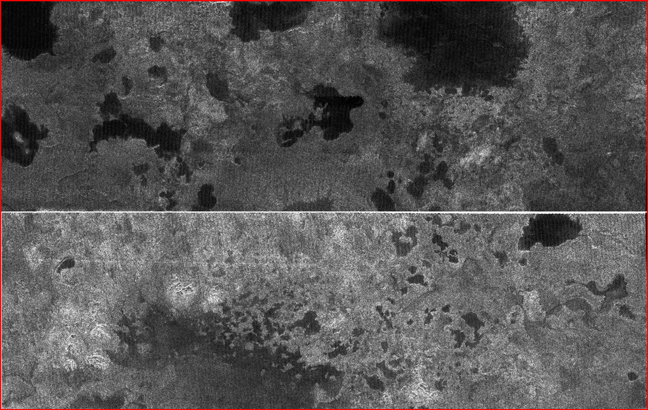
home •
about •
essential guide •
picture of the day •
thunderblogs •
news •
multimedia •
predictions •
products •
get involved •
contact
picture of the day archive subject index
NASA scientists have expressed confidence that the dark patches in the radar images above are lakes of
methane in Titan’s polar region. (See larger picture here)
Aug 02, 2006
Methane Lakes on Titan?
NASA scientist believe they see “lakes of methane” on Saturn’s moon Titan, but electrical theorists suggest another possibility.
Since posting our Picture of the Day on July 30, more than one reader has wondered if we’ve seen recent announcements by NASA of “methane lakes” on Titan. We certainly have, and it is a good opportunity to test the predictive ability of two starkly contrasting interpretations.From a NASA news release: “The Cassini spacecraft, using its radar system, has discovered very strong evidence for hydrocarbon lakes on Titan. Dark patches, which resemble terrestrial lakes, seem to be sprinkled all over the high latitudes surrounding Titan's north pole.”
The Cassini investigators have also noted that sinuous channels or “riverbeds” appear to feed into the presumed methane lakes, giving the appearance of consistency to the interpretation.
But other considerations can hardly be ignored. Every observed “river” on Titan is dry. All of the channels have exposed floors. There is no evidence of any liquid flowing into the flat dark areas. In fact, the situation is not unlike the darkened “mares” of our own moon into which “flow” empty channels called sinuous rilles. Acknowledging the absence of flowing methane on Titan at this time, NASA investigators have suggested that a “cycle” of methane downpours and surface droughts must occur on the moon. "The lakes are presumably filled by rainfall, perhaps by seasonal storms, and then evaporate slowly to replenish the atmosphere and complete Titan's methane cycle."
But as noted by Mel Acheson, NASA’s “big problem is explaining the loss of atmospheric methane to space. Early speculations were of methane volcanoes to bring up vast underground supplies”—a process claimed to have been underway for eons to maintain the necessary atmospheric levels.
Acheson points out that a methane rain cycle just takes existing methane around a phase-shift circle (vapor to liquid to vapor). That's pretty much the entire meaning of "cycle". Cycling doesn't produce "new" methane to replenish any loss. A loss is a loss: there is less methane to cycle. They need to speculate that the lakes are fed by underground springs, or some such mechanism. But no such volcanoes have been observed, leading NASA theorists to suppose that this phase of “activity” is “temporarily” quiescent.
As Acheson comments, “the attraction of ‘underground’ anything is that it can't be tested—so the search for an explanation is shifted from empirical ground to a ground of theoretical ‘consensus.’”
Electrical theorist Wallace Thornhill offers an interpretation easily contrasted with that of NASA scientists: “The radar images show flat-floored depressions with circular scalloped edges, typical of arc machining of the surface. I would compare them directly to the scalloped scarring on Jupiter’s moon Io and the flat, melted floor depressions that result. Such floors would be expected to give a dark radar return.”
The fact that the "lakes" have only been discovered in the polar region and are associated with empty sinuous "rilles" and fulgurite-like dunes also suggests an electrical origin through powerful auroral currents sometime in the past, according to Thornhill.
It is worth noting here that Thornhill challenged the standard interpretation of Io and its “volcanos” prior to the arrival of the Galileo probe. His predictions were very specific and clearly contrary to NASA’s expectations. Then close-up images of Io’s confirmed the predictions.Today Thornhill’s predictions with respect to the supposed “methane lakes” on Titan and related surface features could provide an equally compelling test.COMING AUGUST 4: Predictions Concerning Titan’s Methane
___________________________________________________________________________Please visit our Forum
The Electric Sky and The Electric Universe available now!

|
|

|
EXECUTIVE EDITORS:
David Talbott, Wallace Thornhill
MANAGING EDITORS:
Steve Smith, Mel Acheson
CONTRIBUTING EDITORS: Dwardu Cardona, Ev Cochrane,
C.J. Ransom, Don Scott, Rens van der Sluijs, Ian Tresman
WEBMASTER: Brian Talbott
Copyright 2006: thunderbolts.info
![]()
home •
thunderblogs •
forum •
picture of the day •
resources •
team •
updates •
contact us

